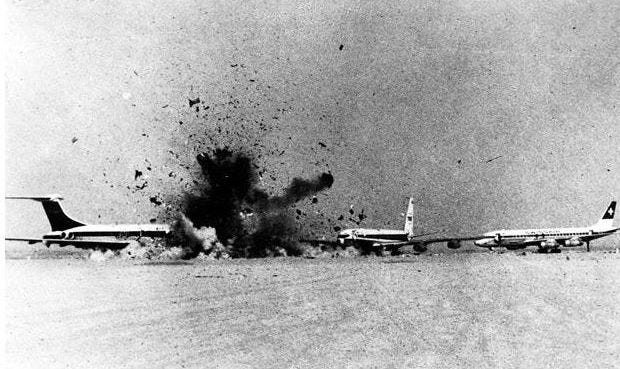
On September 6, 1970, CBS News Anchor Harry Reasoner and London correspondent Charles Collingwood reported on the hijacking of three international flights and the attempted hijacking of a fourth. A news junkie at 12, I must have watched the reports all week as my parents sipped a pre-dinner cocktail.
What I didn’t know was that someone who would become my friend was on one of those planes.
In 1970, hijackings were shockingly common, and while piracy is a centuries-old crime, aircraft hijacking was a relatively recent one. The first hijacking probably occurred in 1929, when revolutionaries in Arequipa, Peru, ordered an American pilot to fly them to Lima, the capital, where an insurrection was taking place. But there were fewer than two dozen hijackings before World War II—partly because commercial air travel was so rare. But the post-1945 world left millions of people stranded in countries undergoing the reimposition of colonial regimes, behind Europe’s Iron Curtain, and who were ideological minorities in a politically bipolar Cold War world.
Airline hijackings tended to be political from the get-go, and they nearly always involved hostage-taking to ensure the survival of the hijackers and, increasingly, as television broadcast images and sound across great distances, global attention to a cause. While airlines counseled flight crews to obey hijackers in the interests of passenger safety, these policies also meant that a planeload of civilians became an easy pool of hostages, bargaining chips that compelled governments to negotiate air pirates’ demands.
Those of us who flew regularly in the politically turbulent 1960s were aware of the relative frequency of hijacking. It was a crime that escalated sharply by the end of the decade as, among other things, resistance to United States imperialism and the suppression of colonized people around the world became violent. In the 1960s, there were around 100 hijacking attempts, 40 successful, but between 1968 and 1972, there were 326 of these events around the world. In those four years, ninety hijackers demanded transportation to Cuba, a Communist safe haven that could easily be reached from North America without refueling. In 1970 alone, more than 7,000 passengers were taken hostage around the world. And the risk of harm, while minimal, was ever-present for passengers conscripted into a global narrative: 96 people were killed and 56 injured as armed terrorists took charge of flights originating in almost 50 different countries.
In the United States, the Federal Aviation Administration enhanced penalties for hijacking, began to put plainclothes federal marshals on many flights in the 1960s, and initiated the airport screenings that have become so rigorous today. But the crime didn’t go away completely. In 2001, there were only five hijackings, but they were deadlier than all previous incidents combined. On September 11 of that year, hijackers deliberately crashed two of those planes into the twin towers of the World Trade Center and one into the Pentagon in Washington, D.C. A fourth went down in Pennsylvania when passengers fought the hijackers for control of the flight.
On that day, the first of the new semester, New York University history professor Martha Hodes was headed to her 9:30 class. She heard a boom, pausing briefly to see smoke pouring from the North Tower of the World Trade Center and, as she recalls, “an orange ball of fire” bursting through the South Tower. Yet, she had a class to meet, and she met it. An hour later, the class ended: notified that the towers had fallen, as she puts it, Hodes and her students “emerged into a world transformed.”
Most of us who experienced 9/11 were shattered by it. Our worlds were upended. I still remember watching the towers crumble, knowing in my heart that our neighborhood ladder company—men who shopped for the firehouse in the local Key Food—were inside and not coming home again.
But Hodes had a different experience. She began to be troubled by memories—because she, too, had been on a hijacked plane on September 6, 1970. TWA flight 741, seized after takeoff from Tel Aviv, Israel, by members of the Popular Front for the Liberation of Palestine, was diverted to an old airstrip near Amman, Jordan. Hodes was twelve at the time, traveling with her older sister Catherine but unaccompanied by an adult family member. She spent a week on the plane—toggling between boredom, new alliances with the other passengers, and writing in her diary.
Those, and more troubling recollections, began to surface. How could she be sure what had happened? What was the status of these new, conflicting memories?
Historians rely on diaries and on the memories of living people when we reconstruct events. But as Hodes began to re-read her childhood account of this harrowing week, she realized that her diary concealed as much as it illuminated. So, she did what any upstanding scholar would do in a similar situation: research.
I’ll let Martha tell her own story, as she has in her new book, My Hijacking: A Personal History of Forgetting and Remembering (HarperCollins, 2023). But let me begin by saying the book does its work. Spinning backward in time, sifting Hodes’s memories to find the truth of her experience, My Hijacking reminds us that our past selves and the people we write about sometimes evade us by refashioning the past.
They beckon us to find them—even as they artfully conceal themselves.
They have their reasons.
You can download this podcast here or subscribe for free on Apple iTunes, Spotify, Google Podcasts, or Soundcloud. And if you liked this episode, please join us!
Program notes:
The opening clip is from the CBS Evening News report on the hijackings, broadcast on September 6, 1970: you can listen to the full report. I also invite you to read a brief history of “skyjacking” by The New York Times’s Nicola Clark and a summary history of the Popular Front for the Liberation of Palestine (PFLP).
You can read a little bit about Martha Graham dancer Stuart Hodes, who passed in March 2023 at the age of 98.
Martha Hodes’s mother, Linda Hodes, is also a distinguished dancer and choreographer: you can read a capsule biography of her and her work with Israel’s Batsheva Dance Company here.
In September 1969, the Cuban government soon made their nation less safe for hijackers: Allison Miller recounted that history in April 2021.
Martha mentions the immediate historical context of the hijacking: the 1967 Arab-Israeli war, sometimes known as the Six-Day War.
Sociologist Sylvia Jacobson, a fellow hostage who interviewed the Hodes sisters after the hijacking, recounted her experiences for the Florida Times-Union here.
If you liked these reflections on writing personal history, you might also like Episode 16, The Sunlit Path of Racial Justice, a conversation with historian Matthew Pratt Guterl about his book, "Skinfolk: A Memoir."






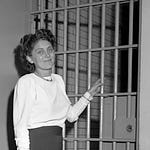
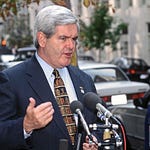


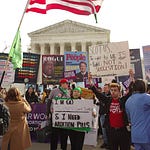
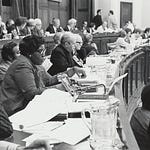

Share this post